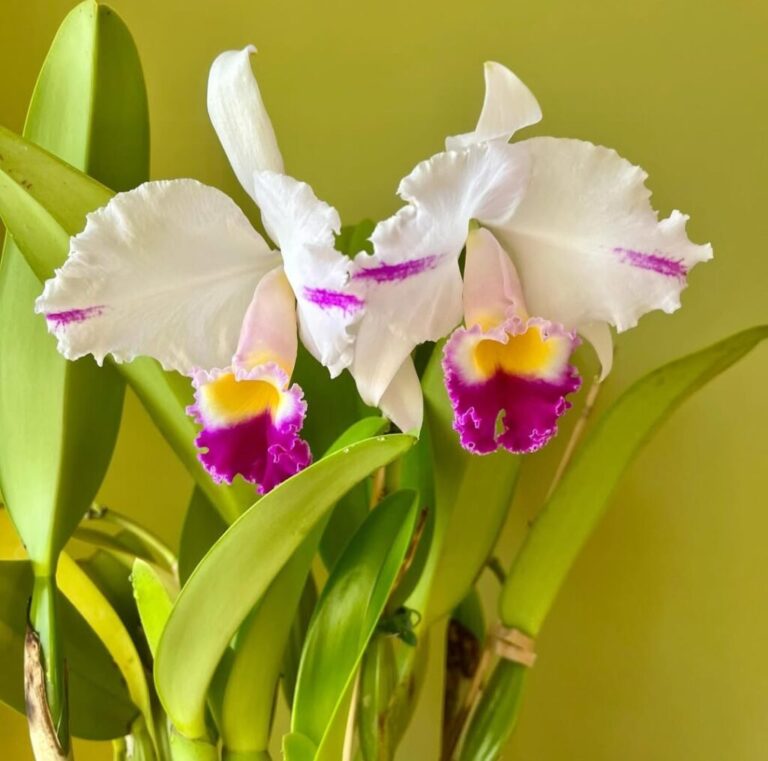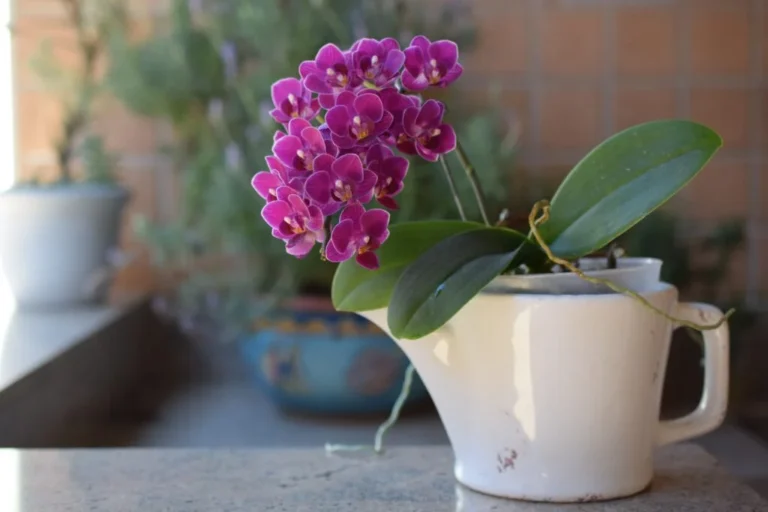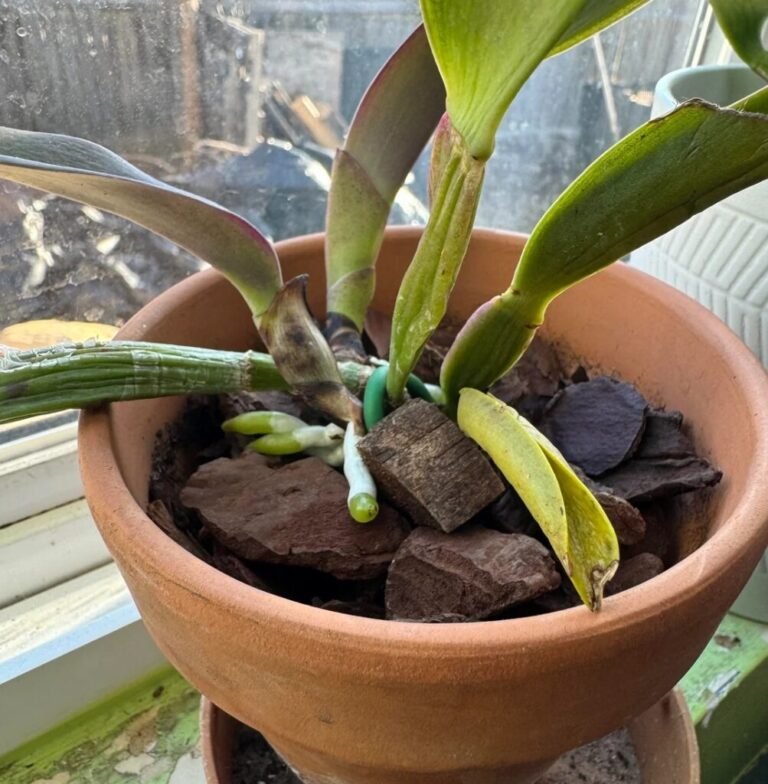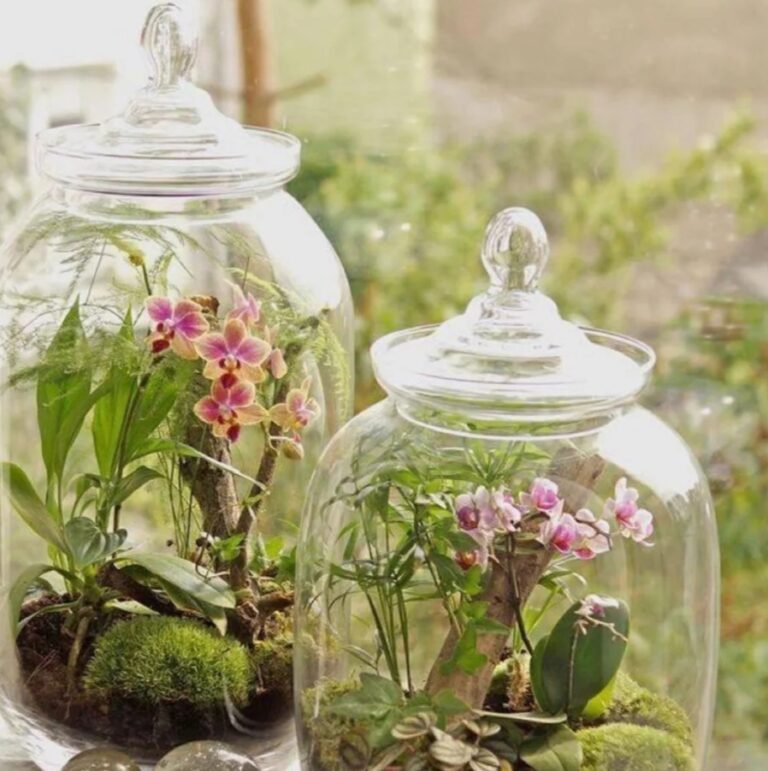Mini orchids are the perfect way to add a splash of beauty to your home without taking up too much space. With their small size and striking flowers, these charming plants are perfect for beginners who want to experience the joy of growing orchids. If you’re just starting out or looking for tips to keep your mini orchid in top shape, you’re in the right place! In this guide, we’ll share 12 simple, effective steps that will help your mini orchid thrive and bloom beautifully. Whether you’re growing it on your windowsill or as part of a plant collection, these tips will ensure your orchid stays healthy and vibrant for years to come. Let’s get started!
Proper care is key for mini orchids to thrive. With over 30,000 orchid species, knowing their needs is vital. Mini orchids need the right light, water, and nutrients to bloom beautifully.
Each orchid species, including mini ones, has its own needs. To care for your mini orchids well, learn about their natural habitats and growth patterns. This knowledge helps you create the perfect environment for them to bloom and thrive.
- 1 Mini Orchid Plant
- 2 Understanding Mini Orchids: Species and Characteristics
- 3 Essential Equipment for Mini Orchid Success
- 4 The Truth About Mini Orchid Light Requirements
- 5 Watering Techniques That Won’t Kill Your Mini Orchid
- 6 Mini Orchid Care 101: Temperature and Humidity Control
- 7 Potting Medium Secrets for Thriving Mini Orchids
- 8 Fertilization: When Less Is More
- 9 Pruning and Maintenance Schedule
- 10 Recognizing and Treating Mini Orchid Problems
- 11 Reblooming Tips and Techniques
- 12 Creating the Perfect Mini Orchid Display
- 13 Conclusion: Mastering Your Mini Orchid Journey
- 14 FAQ
Mini Orchid Plant

Learning about mini orchid care can make you a great orchid grower. This article will give you tips on light, water, and nutrients for your mini orchids. Whether you’re new or experienced, this article will enhance your care skills and let you enjoy these beautiful plants.
Key Takeaways
Proper mini orchid care is essential for thriving plants
It’s critical to comprehend the unique requirements of your orchid species.
Mini orchid care involves providing the right environment, including light, water, and nutrients
Orchid care tips can help you create an environment that meets the needs of your mini orchids
Learning about mini orchid care can help you become a successful orchid grower
Improving your mini orchid care skills can help you enjoy the beauty of these stunning plants
Understanding Mini Orchids: Species and Characteristics
Mini orchid species have unique traits that make them stand out. It’s important to know where they come from and how they grow. These plants can be found all over the world, and their growth is shaped by their surroundings.
Popular mini orchids include Phalaenopsis and Dendrobium. Phalaenopsis is famous for its long-lasting flowers. Dendrobium is loved for its delicate blooms. Knowing what each needs is key to caring for them.
Popular Mini Orchid Varieties
Phalaenopsis: known for its long-lasting flowers
Dendrobium: prized for its delicate blooms
Oncidium: recognized for its small, delicate flowers

Natural Habitat Characteristics
Mini orchids love humid, moderate temperatures. They grow best in bright, indirect light and well-ventilated spots. Mimicking these conditions helps them thrive.
Growth Patterns and Life Cycles
Mini orchids grow in unique ways. Some bloom all year, while others have specific times. Knowing their life cycles helps growers care for them better.
| Mini Orchid Species | Flowering Period | Dormancy |
|---|---|---|
| Phalaenopsis | 2-3 months | 2-3 months |
| Dendrobium | 1-2 months | 4-6 months |
Essential Equipment for Mini Orchid Success
To care for your mini orchids right, you need the right orchid care equipment. This includes orchid pots that breathe well and drain water properly. Also, you’ll need orchid fertilizers made just for orchids. When picking orchid pots, think about your orchid’s size and the potting mix you’ll use.
Here are some key pieces of equipment to get you started:
Orchid pots with good drainage
Orchid fertilizers specifically formulated for orchids
Watering cans with long spouts for precise watering
Potting medium, such as sphagnum moss or perlite
Repotting your mini orchids is key to their care. Do this every 1-2 years, or when the mix breaks down. Use orchid care equipment like potting mix made for orchids and orchid fertilizers to help them grow well. With the right tools and care, your mini orchids will flourish.

| Equipment | Description |
|---|---|
| Orchid pots | Well-ventilated and have good drainage |
| Orchid fertilizers | Specifically formulated for orchids |
| Watering cans | Precise watering with long spouts |
The Truth About Mini Orchid Light Requirements
Understanding the lighting needs of mini orchids is key for their health and blooms. There are two main types of light: natural and artificial. Natural light helps with photosynthesis, while artificial light fills in when sunlight is scarce.
Some important things to consider for mini orchid lighting include:
Place the orchid near an east- or west-facing window for gentle, indirect natural light.
Use artificial light, like LED grow lights, to help when sunlight is low.
Change the light conditions with the seasons to match the orchid’s natural environment.
Knowing the signs of bad light, like leaf scorching or weak growth, is crucial. By understanding what mini orchids need, you can give them the best chance to grow and bloom.
By mixing natural and artificial light, mini orchid lovers can create the perfect spot for their plants. With the right light, mini orchids can bloom beautifully and stay healthy. They make a great addition to any home or garden.
| Lighting Type | Benefits | Considerations |
|---|---|---|
| Natural Light | Promotes photosynthesis, healthy growth | May be limited by seasonal changes, window direction |
| Artificial Light | Supplements natural light, promotes healthy growth | May be expensive, requires proper placement and adjustment |
Watering Techniques That Won’t Kill Your Mini Orchid
Proper watering orchids techniques are key to keeping your mini orchids healthy. Overwatering can cause root rot and kill your orchid. It’s important to know the right orchid watering techniques for your mini orchid.
Here are some tips to help you water your mini orchid correctly:
Water your orchid once every ten to fourteen days in the winter and once a week in the summer.
The roots may be shocked by cold water, so use lukewarm water.
Water your orchid in the morning, so the plant has the entire day to dry out.
Avoid overwatering by checking the moisture level of the potting medium before watering. Stick your finger into the potting medium up to the first knuckle.It’s time to water your orchid if it seems dry.
| Watering Frequency | Season |
|---|---|
| Once a week | Summer |
| Once every 10-14 days | Winter |
By following these orchid watering techniques, you can ensure your mini orchid gets the right water. Remember, it’s safer to underwater slightly than to overwater your orchid.
Mini Orchid Care 101: Temperature and Humidity Control
Keeping the right temperature and humidity is key for mini orchids to do well. Knowing the best temperature and humidity levels helps your mini orchids grow and bloom.
Temperature is very important for mini orchids. They like daytime temperatures between 65-75°F (18-24°C) and cooler nights around 55-65°F (13-18°C). Humidity control is also crucial. Mini orchids need a humid spot, usually between 40-70% relative humidity.
Optimal Temperature Ranges
- Daytime temperatures: 65-75°F (18-24°C)
- Nighttime temperatures: 55-65°F (13-18°C)
Humidity Management Methods
To keep humidity right, you can use a humidifier or group plants together. It’s also important to watch the temperature to make sure it’s just right for your mini orchids.
Seasonal Adjustments
As seasons change, adjust temperature and humidity to match your mini orchids’ natural home. This helps them thrive and bloom all year.
Potting Medium Secrets for Thriving Mini Orchids
Choosing the right orchid potting medium is key for mini orchids. A good mix offers nutrients, air, and moisture for healthy roots. Popular options include sphagnum moss, coconut husk, and bark-based mixes.
Think about what your mini orchid needs. Some like acidic mixes, while others prefer alkaline. Also, consider how much moisture and air your orchid needs.
Repotting is vital for mini orchid care. You should repot your orchid every 1-3 years. This gives it fresh medium and a bigger pot if it needs one. When repotting, handle the roots carefully and trim any dead ones. Then, put the orchid in its new home with fresh medium.
Choose a potting medium that is well-draining and aerated.
Consider the specific needs of your mini orchid when selecting a potting mix.
Repot your orchid every 1-3 years to provide fresh potting medium and a larger pot if necessary.
Using the right orchid potting medium and repotting correctly helps your mini orchid grow and bloom. Keep an eye on how your orchid reacts to its medium. Adjust as needed to keep it healthy and happy.
Fertilization: When Less Is More
Orchid fertilization is key in caring for mini orchids. The right fertilizers help with growth and blooming. But, too much can harm the plant. Knowing the different fertilizers and how to use them is crucial.
Types of Fertilizers
There are many fertilizers out there, like liquid ones and sticks. Liquid fertilizers are simple to apply. You can spray them on the leaves or mix them with water. Fertilizer sticks slowly release nutrients to the plant.
Application Schedule
Creating a fertilization schedule is important to avoid overfertilizing. Fertilize your mini orchid once a month. Use a balanced fertilizer made for orchids. Always follow the package instructions to avoid harming your plant.
Some common mistakes to avoid include:
Using too much fertilizer, which can cause overfertilization
disregarding the fertiliser package’s directions
Not using a balanced fertilizer that is specifically formulated for orchids
By following these tips and choosing the right fertilizers, you can help your mini orchids grow and bloom.Appreciate these gorgeous plants’ beauty.
Pruning and Maintenance Schedule
Pruning orchids is key to their health. It helps them grow well and keeps diseases away. Cutting off dead or damaged parts encourages your orchid to flourish. Trimming back overgrown plants also helps, making them look better and grow new leaves.
Choosing the right tools for pruning is crucial. Sharp, clean scissors or shears are best to avoid spreading disease. Prune your orchid when it’s the right time to avoid stressing it out. Pruning orchids might seem hard, but with the right tools and timing, your orchid will stay healthy.
Here are some tips for a good pruning schedule:
Prune your orchid after it finishes blooming to encourage new growth
Remove dead or damaged leaves or stems to prevent disease
Trim back overgrown plants to keep them healthy and prevent them from getting too long
Follow these tips and use the right pruning techniques to keep your orchid in top shape. Always use clean tools and prune at the right time to avoid stressing your orchid. With regular care, you’ll enjoy beautiful, healthy orchids for many years.
Recognizing and Treating Mini Orchid Problems
Mini orchids face many issues like diseases, pests, and root problems. It’s key to spot and fix these early to keep your orchids healthy.
Root health is a big concern for mini orchids. Bad root health can cause diseases and pest problems. To avoid this, repot your orchids often and use a potting mix that drains well.
Disease Identification
Orchid diseases come from fungi, bacteria, or viruses. Look out for yellow leaves, black spots, and soft roots. To fight diseases, use orchid-specific fungicides and insecticides.
Pest Management
Controlling pests is vital to stop diseases from spreading. Pests like mealybugs, spider mites, and scale can harm your orchids. Use insecticides and keep your hands clean when handling your plants.
Root Health Issues
Root problems can be due to too much or too little water, or bad potting mix. To solve this, water carefully and use a good potting mix. Check your orchids’ roots often to catch issues early.
Early action can keep your orchids healthy and vibrant. Always practice good hygiene, use quality potting mix, and watch your orchids’ roots to avoid diseases, pests, and root problems.
| Problem | Symptoms | Treatment |
|---|---|---|
| Orchid diseases | Yellowing leaves, black spots, soft roots | Fungicides, insecticides |
| Pest control issues | Mealybugs, spider mites, scale | Insecticides, good hygiene |
| Root health issues | Overwatering, underwatering, poor potting medium | Proper watering, well-draining potting medium |
Reblooming Tips and Techniques
To get reblooming orchids to bloom more, you need to create the right environment. This means giving them enough light, keeping the temperature just right, and managing humidity. Knowing what your mini orchid needs can help it bloom more and longer.
Some important things to think about for reblooming orchids include:
Lighting: Make sure your mini orchid gets enough light to bloom well.
Temperature: Keep the temperature right to help it grow and bloom.
Humidity: Control humidity to avoid problems and help your orchid thrive.
By following these tips, you can get your mini orchid to bloom more. This way, you can enjoy its beauty for a longer time. Also, remember to prune and train your orchid to help it bloom again and stay healthy.
With the right care, you can enjoy the beautiful blooms of your mini orchid. By giving it the right conditions and using the right techniques, you can make it bloom again and again.
Creating the Perfect Mini Orchid Display
Showing off your mini orchids in a beautiful display can really make a difference. A stunning orchid display not only adds elegance to your home but also helps your plants grow well. To make a beautiful display, think about container selection, arrangement ideas, and the look you want to achieve.
Picking the right container is key for a great display. Think about the size and type of your mini orchid when choosing a container. A small orchid might look best in a tiny glass vase, while a bigger one needs a bigger container.
Popular choices for container selection include:
- Terracotta pots
- Glass vases
- Ceramic planters
Tip: When choosing a vase for orchids, opt for one with drainage holes to ensure proper airflow and prevent root rot. Orchids have two types of roots—one absorbs moisture from the air, while the other anchors the plant to trees or potting media. Vases without holes trap excess moisture, increasing the risk of rot.
Along with container selection, arrangement ideas can also make your display more beautiful. You could group several orchids together for a stunning centerpiece, or put one orchid in a fancy vase. Adding moss or branches with your orchids can make a unique and eye-catching orchid display.
To create the perfect mini orchid display, try out different arrangement ideas and container selection options. With a bit of creativity and patience, you can make a stunning orchid display that highlights your mini orchids and adds elegance to your home.
| Container Type | Orchid Size | Arrangement Idea |
|---|---|---|
| Terracotta pot | Small | Group with moss and branches |
| Glass vase | Medium | Place solo with decorative rocks |
| Ceramic planter | Large | Combine with other orchids and greenery |
Conclusion: Mastering Your Mini Orchid Journey
Learning to care for mini orchids is a journey filled with rewards. This guide has given you the tools to grow healthy mini orchids. Remember, success comes from patience, persistence, and a love for learning.
Start your mini orchid journey with excitement and a positive attitude. Every bloom and healthy leaf shows your growing skills. Keep trying new things and learn about what your orchids need.
Don’t be shy to share your mini orchid stories with others. Joining a community of growers can teach you a lot. It also helps inspire and help new growers, making mini orchid care better for everyone.
Enjoy the journey of caring for your mini orchids. With hard work and attention, you’ll see your collection flourish. You’ll become a true expert in this beautiful hobby.
FAQ
What are the popular mini orchid varieties?
Popular mini orchids include Phalaenopsis (Moth Orchids) and Dendrobium. They are known for their small size, bright colors, and long-lasting flowers.
What are the natural habitat characteristics of mini orchids?
Mini orchids come from tropical and subtropical areas. They grow on trees or rocks. They need high humidity, moderate temperatures, and filtered light.
What type of equipment is essential for mini orchid care?
You’ll need the right pots, potting medium, fertilizer, and a hygrometer. These tools help keep your orchid healthy.
Can I Keep a Mini Orchid Plant in My Bathroom?
Yes, a mini orchid plant can thrive in a bathroom if there is enough indirect light and air circulation. The natural humidity from showers can benefit the plant, but ensure it’s not too damp to prevent rot.
How Do I Trim Dead Flowers on My Mini Orchid Plant?
Once the flowers fade, trim the spike above a node to encourage reblooming. If the spike turns brown, cut it at the base to allow your mini orchid plant to focus energy on new growth.
Should I Mist My Mini Orchid Plant?
Misting a mini orchid plant can help increase humidity, but it’s not always necessary. Instead, placing a humidity tray nearby or using a room humidifier is a better way to keep moisture levels stable.
How Long Does a Mini Orchid Plant Live?
With proper care, a mini orchid plant can live for many years, even decades. Regular watering, feeding, and repotting will help extend its lifespan
Can I Grow a Mini Orchid Plant Without Soil?
Yes! A mini orchid plant can grow in bark, sphagnum moss, or even mounted on wood with proper humidity. These orchids are epiphytes, meaning they absorb moisture and nutrients from the air.
Why Are the Leaves on My Mini Orchid Plant Turning Yellow?
Yellowing leaves on a mini orchid plant can be caused by overwatering, excessive direct sunlight, or natural aging. Adjust care accordingly to maintain a healthy plant.
How Do I Prevent Pests on My Mini Orchid Plant?
Common pests like spider mites, mealybugs, and scale can attack your mini orchid plant. Wipe leaves with a damp cloth and use insecticidal soap or neem oil if needed.
Can a Mini Orchid Plant Grow in a Terrarium?
Yes, a mini orchid plant can grow in a terrarium as long as there is good air circulation, proper drainage, and indirect light. However, avoid excess humidity, which can cause rot.
What Type of Fertilizer Should I Use for My Mini Orchid Plant?
Use a balanced orchid fertilizer (such as 20-20-20) diluted to half strength every 2-4 weeks. This helps your mini orchid plant stay healthy and promotes flowering.
How Can I Get My Mini Orchid Plant to Bloom Again?
To encourage reblooming, ensure your mini orchid plant gets enough light, proper watering, and occasional fertilization. A slight drop in temperature at night can also trigger blooming.
What Temperature is Best for a Mini Orchid Plant?
The ideal temperature for a mini orchid plant is between 65-75°F (18-24°C) during the day and slightly cooler at night. Avoid sudden temperature changes.
How Do I Repot a Mini Orchid Plant?
Repot your mini orchid plant every 1-2 years using a special orchid mix. Gently remove old potting material, trim dead roots, and place the orchid in a slightly larger pot.






